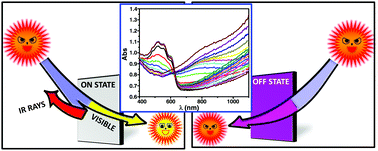Polythiophene-nanoWO3 bilayer as an electrochromic infrared filter: a transparent heat shield†
Abstract
A power-efficient, ultrafast and stable organic–inorganic hybrid electrochromic device fabricated using WO3 and P3HT as active materials has been demonstrated herein for dual application in an electrochromic window as well as an IR filter. The device when turned ON using a bias as low as 1 V shows heat shielding effect as well as increased optical transparency to keep the area cooler by ∼8 °C (22%) to maintain the room temperature at 302 K, as imaged using an IR camera. The solid state electrochromic IR filter device was fabricated in simple cross bar geometry with the WO3/P3HT bilayer sandwiched between two electrodes. The device works on the principle of a bias-induced redox change process, as established using electrochemical and spectroscopic investigations. The device exhibits superior electrochromic behavior with dual function, with a maximum color contrast of ∼60% in the IR region with excellent coloration efficiency of ∼380 cm2 C−1 at 520 nm and stability of more than 1600 ON/OFF cycles without compromising its performance. Possibility of the device to be used as an electrochromic window and heat shield has been demonstrated using real life experiments.



 Please wait while we load your content...
Please wait while we load your content...